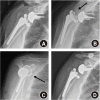Complications of reverse shoulder arthroplasty: a concise review
- PMID: 33652512
- PMCID: PMC7943379
- DOI: 10.5397/cise.2021.00066
Complications of reverse shoulder arthroplasty: a concise review
Abstract
Reverse shoulder arthroplasty is an ideal treatment for glenohumeral dysfunction due to cuff tear arthropathy. As the number of patients treated with reverse shoulder arthroplasty is increasing, the incidence of complications after this procedure also is increasing. The rate of complications in reverse shoulder arthroplasty was reported to be 15%-24%. Recently, the following complications have been reported in order of frequency: periprosthetic infection, dislocation, periprosthetic fracture, neurologic injury, scapular notching, acromion or scapular spine fracture, and aseptic loosening of prosthesis. However, the overall complication rate has varied across studies because of different prosthesis used, improvement of implant and surgical skills, and different definitions of complications. Some authors included complications that affect the clinical outcomes of the surgery, while others reported minor complications that do not affect the clinical outcomes such as minor reversible neurologic deficit or minimal scapular notching. This review article summarizes the processes related to diagnosis and treatment of complications after reverse shoulder arthroplasty with the aim of helping clinicians reduce complications and perform appropriate procedures if/when complications occur.
Keywords: Complications; Replacement; Rotator cuff tear; Rotator cuff tear arthropathy; Shoulder; Arthroplasty.
Conflict of interest statement
None.
Figures






Similar articles
-
Short and midterm results of reverse shoulder arthroplasty according to the preoperative etiology.Arch Orthop Trauma Surg. 2013 Apr;133(4):463-71. doi: 10.1007/s00402-013-1688-7. Epub 2013 Feb 6. Arch Orthop Trauma Surg. 2013. PMID: 23385301
-
Outcomes after shoulder replacement: comparison between reverse and anatomic total shoulder arthroplasty.J Shoulder Elbow Surg. 2015 Feb;24(2):179-85. doi: 10.1016/j.jse.2014.06.039. Epub 2014 Sep 9. J Shoulder Elbow Surg. 2015. PMID: 25213827
-
Complications in reverse total shoulder arthroplasty.J Am Acad Orthop Surg. 2011 Jul;19(7):439-49. J Am Acad Orthop Surg. 2011. PMID: 21724923 Review.
-
Complications of the reverse prosthesis: prevention and treatment.Instr Course Lect. 2012;61:157-68. Instr Course Lect. 2012. PMID: 22301230 Review.
-
Does lateralisation of the centre of rotation in reverse shoulder arthroplasty avoid scapular notching? Clinical and radiological review of one hundred and forty cases with forty five months of follow-up.Int Orthop. 2016 Jan;40(1):99-108. doi: 10.1007/s00264-015-2976-3. Epub 2015 Sep 4. Int Orthop. 2016. PMID: 26338343
Cited by
-
Surgical Outcomes of Weight-Bearing Shoulders: Arthroscopic Rotator Cuff Repair and Reverse Shoulder Arthroplasty.Clin Orthop Surg. 2025 Jun;17(3):438-452. doi: 10.4055/cios24238. Epub 2025 Jan 7. Clin Orthop Surg. 2025. PMID: 40454117 Free PMC article.
-
The Treatment of Periprosthetic Fracture Revision of the Humerus with "Bamboo Support" Structural Allograft Technique-Atrophic Non-Union of a Post-Operative Periprosthetic Fracture after Reverse Total Shoulder Arthroplasty: A Case Report.J Clin Med. 2024 Jan 31;13(3):825. doi: 10.3390/jcm13030825. J Clin Med. 2024. PMID: 38337518 Free PMC article.
-
Humeral stem with low filling ratio reduces stress shielding in primary reverse shoulder arthroplasty.Int Orthop. 2022 Jun;46(6):1341-1349. doi: 10.1007/s00264-022-05383-4. Epub 2022 Mar 30. Int Orthop. 2022. PMID: 35353240
-
Reverse shoulder arthroplasty versus hemiarthroplasty versus non-surgical treatment for older adults with acute 3- or 4-part fractures of the proximal humerus: study protocol for a randomised controlled trial (PROFHER-2: PROximal Fracture of Humerus Evaluation by Randomisation - Trial Number 2).Trials. 2023 Apr 13;24(1):270. doi: 10.1186/s13063-023-07259-3. Trials. 2023. PMID: 37055816 Free PMC article.
-
Cutibacterium acnes in Shoulder Surgery: Is It a Significant Risk Factor for Postoperative Infection?Clin Orthop Surg. 2024 Dec;16(6):845-853. doi: 10.4055/cios23371. Epub 2024 Jun 7. Clin Orthop Surg. 2024. PMID: 39618529 Free PMC article. Review.
References
-
- Levy JC, Everding NG, Gil CC, Jr, Stephens S, Giveans MR. Speed of recovery after shoulder arthroplasty: a comparison of reverse and anatomic total shoulder arthroplasty. J Shoulder Elbow Surg. 2014;23:1872–81. - PubMed
-
- Bacle G, Nové-Josserand L, Garaud P, Walch G. Long-term outcomes of reverse total shoulder arthroplasty: a follow-up of a previous study. J Bone Joint Surg Am. 2017;99:454–61. - PubMed
-
- Ascione F, Domos P, Guarrella V, Chelli M, Boileau P, Walch G. Long-term humeral complications after Grammont-style reverse shoulder arthroplasty. J Shoulder Elbow Surg. 2018;27:1065–71. - PubMed
LinkOut - more resources
Full Text Sources
Other Literature Sources
Research Materials

